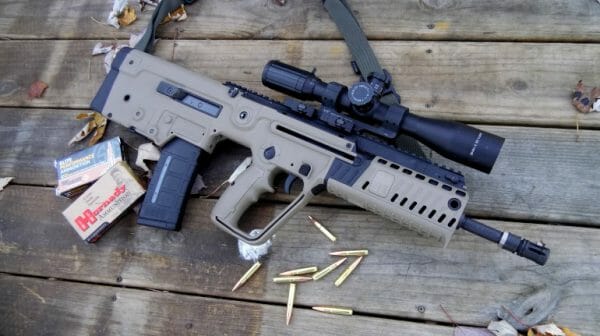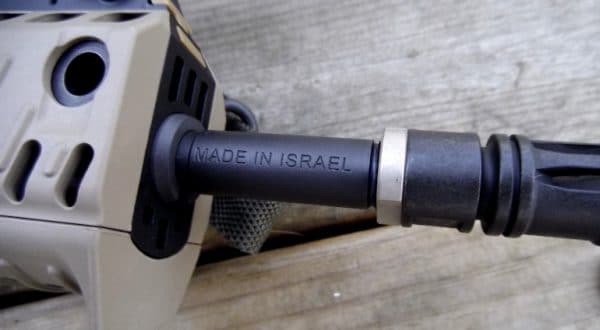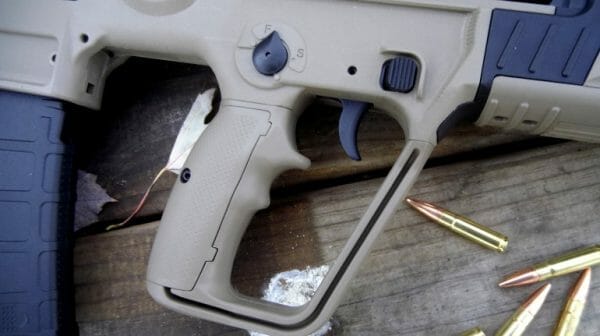
U.S.A. –-(Ammoland.com)- The bullpup rifle has always had a hard time clicking with the American consumer. While the layout has been around for quite some time, the execution of many a design has failed to attract more than a passing “that’s cool” from end users. All that changed with the introduction of the Tavor SAR from IWI and the subsequent X95, which is the subject of this article.
The IWI Tavor X95 is a current generation Israeli military rifle. While there are some differences between the commercial model and the actual Israeli military version, they are in principle the same gun. The rifle was originally adopted for service in 2009 and has gone by several names including the MTAR 21 and Micro Tavor, with the latter being somewhat of a misnomer as it is not substantially smaller than the full-size Tavor SAR. While the real deal rifles in Israel are somewhat different in weight and length, the versions that we get here are basically the same at just under 8lbs and about 26” overall.

The differences tend to stop at the cosmetic. The US version I have here is functionally the same as the military versions, less full auto capability, but has a slightly thicker butt pad that allows it to meet overall length requirements under US law. The barrel is also longer at 16” as opposed to the typical 13” military type, although barrels as long as 16” are fielded by the IDF. The rifle also has a slightly longer handguard than the military version.
IWI Tavor X95 300 BLK
The major separation from the military X95 is the fact that this rifle is chambered in .300 Blackout. The chambering choice makes a tremendous amount of sense for many American shooters due to the fact that .300 BLK is both plentiful and a suitable choice for hunting larger game as opposed to 5.56mm.
When it comes to the American idea of rifles, bullpups often fall into a strange void of understanding. While compact, they offer a full-length barrel. Often times the 26” length is shorter than a comparable rifle with the stock folded. The American idea of rifle-craft is based heavily around individual accuracy and the ability of the shooter to manipulate the gun quickly, but this is not necessarily the idea the X95 was built around.

The bullpup rifle family has always struggled against traditional rifle layouts because they are comparatively difficult to use and master. The controls are always in the ‘wrong’ place and the manual of arms is night-and-day from the standard AR series. The American rifleman today almost always has both his hands within mere millimeters of the controls of the rifle and can fire and reload in simple, fluid motions. This cannot be done as easily with a bullpup due to the fact that the controls are spaced out in an odd way and cannot be manipulated with the same ease.
The X95 design has addressed some, but not all, of the classic bullpup deficiencies through clever innovation. I will explain some of this by looking at the loading cycle. When the last round is fired, the bolt locks back on an empty mag. The ambidextrous magazine release is a bit of a reach high and forward of the trigger, however, it does become second nature given some practice. With the bolt locked back, a fresh magazine can be inserted. There is no lever on the side of the rifle like on an AR, instead, there is a release lever directly behind the magwell. It can be operated by pushing up on it to release the bolt.
If you want to, you can insert a magazine on a closed bolt. The side-mounted charging handle can be pulled to the rear and released to load the rifle. The charging handle is non-reciprocating. It is important to note that the rifle can be converted to left-handed use and ejection, which is a huge plus for many end users.

While it can be annoying, firing the rifle left-handed is not impossible, but you have to be aware of your chin placement so you don’t get brass bouncing off your face or caught in your beard. I ran the rifle through a few drills lefthanded and it was ok, but not as easy as shooting righthanded. This left/right-hand debacle has always been a point of contention between bullpup and traditional rifle users. The AR is substantially easier to use with both hands but is not quite as compact. In a game of unlimited tradeoffs, you’ll have to pick your poison and get good with it.
The bullpup layout has another significant problem which is sighting options. The compact overall size of the X95, and other bullpups means that there is only a limited amount of real estate to mount scopes of any decent magnification. The rifle comes with a set of folding iron sights. The front sight has a tritium insert which is a small, but thoughtful, addition. If lights and lasers are your thing, there are rails cleverly hidden under the front grip area.

For my accuracy and ballistic data portion of this review, I fired several kinds of .300 Blackout ammo from a number of good companies. Accuracy is the result of five, five-shot groups at 100 yards. Velocity is the average of ten shots over my Oehler 35P chronograph.
- SIG SAUER 120gr HT—————————————– 2290fps, 3.5”
- SIG SAUER 125gr OTM—————————————2210fps, 2.25”
- Hornady Custom 135gr FTX——————————–2100fps, 3.5”
- Hornady 125gr American Gunner————————2202fps, 3.25”
- Mid America Munitions 200gr Broadhead————– 990fps, 2.75”
The rifle had no issues with any sort of with cycling ammo, including the sole subsonic load from Mid America Munitions. I have a hard time finding rifles that will reliably cycle subsonic ammo unsuppressed, but the X95 surprised me and shot it just like the supersonic ammo I tested alongside it. Recoil was very, very low and shooting fast while staying on target was easy.
The rifle was fired with both iron sights and my SWFA SS 3-15×42 scope in a Midwest Industries QD mount. I noticed that there was no real difference in accuracy for me, which was curious as I usually get a smidge better accuracy with optics, even at the short range of 100 yards.

I think that the accuracy of this rifle is reasonable for a gun that has a non-traditional stock setup and a heavy trigger. The trigger isn’t terrible, but it is a far cry from what most American shooters are used to. The reset is crisp, but the pull is long and mushy. This has always been an issue for the entire bullpup family and is a major reason why they have struggled to gain acceptance.
The idea behind the X95 is not something that makes a great deal of sense to the American audience. The American idea of the rifleman and individual accuracy isn’t something that resonates with a foreign mindset. The X95 was not designed to be a match-accurate 1,500-yard sniper rifle. It was instead intended to be used in close quarters in a complex urban environment. It can be pushed out quite far, but not with the same level of precision as you’d get from a dedicated rifle. I fired the X95 out to 300 yards and was able to reliably keep it on an IDPA silhouette at that distance.

All in all, I liked my time with the X95. It was a reliable, rugged, and practically accurate rifle that shows some truly interesting innovation. My advice would be to get a low-powered 1-4x optic and use 20 round mags in it, as 30-rounders can be a bit long when trying to shoot prone. I think that the X95 is as close to the ultimate bullpup as you can get. I fail to see where it can improve.
For more on the X95, go IWI’s website at www.iwi.us. Ammo and accessories used in this article can be seen at www.sigsauer.com, www.hornady.com, www.midamericamunitions.com, and www.midwestindustriesinc.com.
About Josh Wayner
Josh Wayner has been writing in the gun industry for five years. He is an active competition shooter with 14 medals from Camp Perry. In addition to firearms-related work, Josh enjoys working with animals and researching conservation projects in his home state of Michigan
